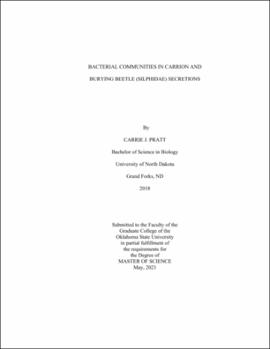| dc.contributor.advisor | Hoback, W. Wyatt | |
| dc.contributor.author | Pratt, Carrie J. | |
| dc.date.accessioned | 2021-09-24T13:58:11Z | |
| dc.date.available | 2021-09-24T13:58:11Z | |
| dc.date.issued | 2021-05 | |
| dc.identifier.uri | https://hdl.handle.net/11244/330942 | |
| dc.description.abstract | The family Silphidae contains about two hundred species of carrion and burying beetles divided into two subfamilies: Silphinae and Nicrophorinae. While both groups exhibit necrophagous feeding patterns, they are differentiated by their reproductive behaviors. Silphinae, known as carrion beetles, oviposit on or near a carcass, hatching free-living larvae that receive no parental care and feed on the carcass and fly larvae. Nicrophorinae, known as burying beetles, exhibit a unique reproductive strategy, preparing a carcass into a brood ball and providing biparental care to their offspring. Adult nicrophorines coat the brood ball in antimicrobial oral and anal secretions that prevent the normal microbial succession of soil and carcass microbes that would cause the carcass to rot. The community of microbes present in these secretions makes up the secretion microbiome, which is distinct from the gut microbiome, the microbiome of carcasses, and the microbiome of prepared carcasses. | |
| dc.description.abstract | Characterizing the silphid microbiome is important to understanding how a specialized group of invertebrates interact with microbes to utilize a carcass and in the case of nicrophorines, efficiently preserve and digest a carcass in order to successfully rear offspring. Studying silphid secretion microbiomes may also provide insights to developing novel antibiotics and methods of meat preservation. The goal of this research was to characterize the secretion microbiomes of silphid species from the two families of Silphidae. First, secretions from Nicrophorus americanus were cultured and bacterial isolates were identified using MALDI-TOF MS and 16S rRNA gene sequencing. Following this, secretions from Necrodes surinamensis, Necrophila americana, and five Nicrophorus spp., N. pustulatus, N. americanus, N. marginatus, N. orbicollis, and N. tomentosus were characterized using culture-independent 16S rRNA gene sequencing. | |
| dc.description.abstract | I cultured and identified thirteen bacterial isolates in nine genera from Nicrophorus americanus secretions and identified 694 bacterial genera from seven species of silphid. I identified a core group of 89 bacterial genera shared across the seven silphid species I sampled. I was unable to find strong evidence that the two subfamilies of Silphidae have different secretion microbiomes or that silphids with differing reproductive styles had significantly different secretion microbiomes. Instead, it appears that silphids share a core group of bacteria that differ in abundance across subfamilies and reproductive styles, and that many of these bacterial genera are associated with other necrophagous insect microbiomes and carcass microbiomes. | |
| dc.format | application/pdf | |
| dc.language | en_US | |
| dc.rights | Copyright is held by the author who has granted the Oklahoma State University Library the non-exclusive right to share this material in its institutional repository. Contact Digital Library Services at lib-dls@okstate.edu or 405-744-9161 for the permission policy on the use, reproduction or distribution of this material. | |
| dc.title | Bacterial communities in carrion and burying beetle (Silphidae) secretions | |
| dc.contributor.committeeMember | Gustafson, John E. | |
| dc.contributor.committeeMember | Ma, Li Maria | |
| dc.contributor.committeeMember | Ochoa Corona, Francisco M. | |
| osu.filename | Pratt_okstate_0664M_17153.pdf | |
| osu.accesstype | Open Access | |
| dc.type.genre | Thesis | |
| dc.type.material | Text | |
| dc.subject.keywords | microbiome | |
| dc.subject.keywords | nicrophorus | |
| dc.subject.keywords | silphidae | |
| thesis.degree.discipline | Entomology and Plant Pathology | |
| thesis.degree.grantor | Oklahoma State University | |
